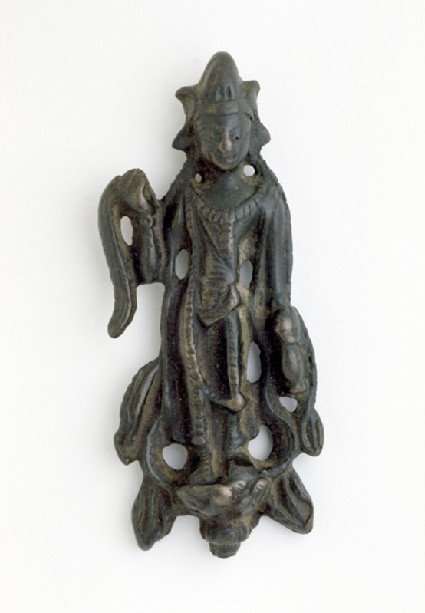Browse: 18 objects
- Reference URL
Actions
Figure of Avalokiteshvara
-
Details
- Associated place
- Date
- 7th - 9th century AD (AD 601 - 900)
- Material and technique
- bronze
- Dimensions
- 8.3 x 3.4 x 1.2 cm max. (height x width x depth)
- Material index
-
processed material › metal › alloy › copper alloy › bronze
- Technique index
- Object type index
- No. of items
- 1
- Credit line
- Purchased, 2000.
- Accession no.
- EA2000.24
-
Further reading
Heller, Amy, Early Himalayan Art (Oxford: Ashmolean Museum, 2008), no. 25 on p. 92, illus. p. 93
Location
-
- currently in research collection
Objects are sometimes moved to a different location. Our object location data is usually updated on a monthly basis. Contact the Jameel Study Centre if you are planning to visit the museum to see a particular object on display, or would like to arrange an appointment to see an object in our reserve collections.
Publications online
-

Early Himalayan Art
This male Bodhisattva may be identified as an aspect of Avalokitesvara, holding a willow branch over his right shoulder and a flask in his left hand [1], which was particularly popular in China during the Tang Dynasty (see also cat. 14 for a contemporary Avalokitesvara image with prabha). Here his extremely thin body is dressed in dhoti and scarves and adorned with bracelets and garlands of beaded necklaces, in the apparel of an Indian prince. The very long lateral scarves descending to the ankle correspond more to Chinese taste of the Tang period, where the scarves' exaggerated curves form recesses around the ankles [2]. The pointed cap he is wearing does not directly reflect either Chinese or Indian costume models. Similar pointed caps with folded flaps at back are worn by certain Tibetan lamas, and by Padmasambhava, a teacher from Uddiyana recognized by Tibetan tradition as the introducer of Tantric Buddhism to Tibet in the mid-eighth century. His iconography was codified much later, but Tibetans consider him as dressed like a foreign teacher of that period. Thus if the origin of such a cap is to be sought in Uddiyana, now identified with either Bengal or more probably the Swat Valley in Pakistan, the representation of this hat is a reflection of Tibetan costume.
Rather than the purely frontal standing posture of the Avalokitesvara image (cat. 14), here the sculpture has been modelled to bend slightly at the shoulders, waist and one knee, adapting the classic Indian triple-flexed posture (tribangha), though the left foot has been broken. He stands on a three-legged pedestal. The dark brown alloy and the almost emaciated body proportions recall models from the Nanzhao kingdom in what is now Yunnan, but the facial features do not recall Chinese sculpture. There appear to be inlays of a different alloy at the eyes, using pitch for the pupils, and inlay of this kind is more characteristic of the western Himalaya. Although the sculpture is quite flat, and the two holes at the level of earrings might have been used to affix it at one time to a board or altar, it was nevertheless cast as a miniature sculpture, not an amulet. This is clear from the consecration lug at the back at the level of the neck, which would have prevented comfortable wearing on the body. A provenance from Tibet or south-east China may be suggested.
[Footnotes:]
1 Published in Anninos, 'Tibetan Buddhist Amulets', fig. 11, there identified as Avalokitesvara/ Guanyin, China or Tibet, 7th-9th century.
2 See Lutz, Der Tempel der Drei Pagoden von Dali, for two sculptures of this form of Avalokitesvara with similar scarves: pl. 100 from Nanzhao kingdom, ninth century, and pl. 101, attributed to Tang China, late seventh to early eighth century.
© 2013 University of Oxford - Ashmolean Museum


